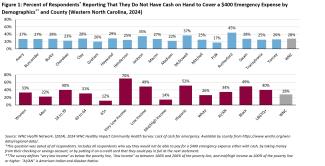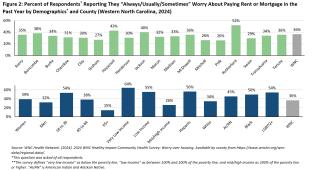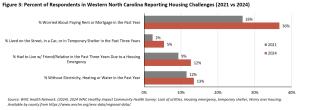
In late January 2025, the WNC Health Network released results from the 2024 Community Health Survey, a regional survey measuring various health, economic, social and housing characteristics of residents in North Carolina’s 18 far western counties[i]. The survey has been conducted every three years since 2012 and was most recently carried out March through June of 2024[ii]. While it was originally designed to describe health challenges and opportunities in the region, its inclusion of financial security and housing stability questions has uniquely positioned the data to identify current housing-related vulnerabilities and opportunities in the wake of Hurricane Helene.
The recency of this data is just one factor that makes it uniquely powerful: similarly expansive data products often lag by two or three years and the most timely data are not always available at the county-level (e.g., the US Census Bureau’s American Community Survey and the US Department of Housing and Urban Development’s CHAS data)[iii]. In addition, because the survey questions were developed with working groups and local partners, they are able to illuminate issues relevant to western North Carolina communities.
For example, one question—respondents’ ability to cover a $400 emergency expense—offers a timely and powerful glimpse into how western North Carolinians were feeling about their financial vulnerability to unexpected expenses months before Hurricane Helene. Three out of ten respondents reported that they did not have cash on hand to cover a $400 emergency expense—and this figure is even higher for Jackson, McDowell and Rutherford counties; the region’s younger residents (under 40); residents with lower incomes; people of color; and LGBTQ+ residents. See Figure 1 below.

Responses to the survey’s five housing affordability and stability questions reiterate the financial vulnerability of many of the region’s residents. For example, the survey asked about respondents’ confidence in their ability to pay for their housing (rent or mortgage). More than one-third of respondents reported worrying about paying for housing “always/usually/sometimes”. Residents of Rutherford, Haywood, Jackson, and Buncombe counties; younger residents (under 40); households with lower incomes; people of color; and LGBTQ+ residents were less confident than the regional average (see Figure 2 below).

This housing instability was reinforced by the survey’s questions about unhealthy and unsafe living conditions; lack of electricity, water or heating; and being unhoused due to a housing emergency. Across most of the region, the share of residents reporting unsafe, unstable, or unaffordable experiences with housing has worsened over time: in nearly every county, a larger percentage of residents report these difficulties in 2024 than during the last survey in 2021 (see Figure 3 below).

Even before Hurricane Helene, western North Carolina’s serious housing affordability and stability challenges threatened the well-being of families and communities and the equitable growth of the region. Federal and state disaster relief resources will help mitigate some of the immediate losses and housing insecurity from Hurricane Helene, but the financial consequences will persist into the future. This is especially true for households with tight budgets, many of whom have likely had to dip into savings or accumulate debt to cover costs.
Hurricane Helene is just the latest event in recent years that has underscored the urgent need for more affordable housing in North Carolina. To learn more about how the NC Housing Finance Agency is helping address the affordable housing shortage in the state, visit https://www.nchfa.com/.
--------------------
[i] Counties included in the survey are Avery, Buncombe, Burke, Cherokee, Clay, Graham, Haywood, Henderson, Jackson, Macon, Madison, McDowell, Mitchell, Polk, Rutherford, Swain, Transylvania and Yancey.
[ii] The survey’s sampling and implementation methodology was designed to be representative of the region’s population to allow for stratification by different demographic characteristics. More information on the methodology is available here.
[iii] For North Carolina, one-year estimates for the American Community Survey are not available for many of the state’s smaller and more rural counties. While five-year estimates can represent small populations and demographic groups with more precision, they can also smooth over recent trends or fluctuations.